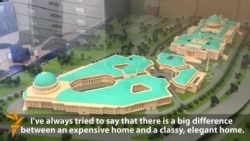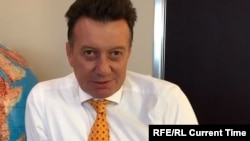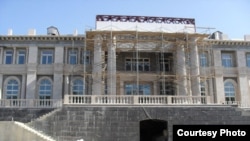MOSCOW -- A mischievous smirk plays on Lanfranco Cirillo's lips as he fields a question about his relationship to the man whose portraits -- two, to be precise -- gaze from the walls of his airy, third-floor office in central Moscow: Russian President Vladimir Putin.
"Like all Russians, I know there is a president," Cirillo told RFE/RL recently in his fluent, if often grammatically flawed, Russian. "He is a very good man. We as citizens all respect him very much."
Cirillo, however, is no ordinary Russian citizen.
The 56-year-old Italian received a Russian passport thanks to Putin. He has moved inside the rarefied world of the gilded class seen as part of Putin's circle -- a secretive milieu known for patron-client networks and a deep-rooted suspicion of foreigners. And he's the designer of a palatial mansion purportedly built for the Russian president -- a job that has earned him the moniker "Putin's Architect."
He now dreams of winning the rights to design a sprawling new parliament building in Moscow, joining the pantheon of Italian architects who have designed landmark Russian seats of power over the centuries -- including Moscow's iconic Kremlin and the Winter Palace in St. Petersburg.
And yet Cirillo was virtually unknown, even in Russia's architectural community, until he was outed nearly five years ago as the designer of what has been dubbed "Putin's Palace," a lavish estate built in utmost secrecy in the Black Sea town of Gelendzhik.
For Russia's political opposition, the property has become a brazen symbol of rampant state corruption running straight to the top.
Precisely how this foreigner's improbable odyssey led to a deal to design what may be Russia's most controversial piece of real estate -- while working with men closely associated with Putin -- remains unclear to many.
Cirillo, for his part, positions himself as a modest man who likes to keep a low profile and who is the product of a post-Soviet version of the American Dream -- a tale of hard work, merit, and good fortune.
Sporting a white shirt with open cuffs and a yellow, patterned necktie, he comes across as jovial and relaxed during a recent interview at his Moscow office. He declines to answer questions about "Putin's Palace," which the Kremlin adamantly denies has any connection to the Russian president, but confirms that he designed the mansion.
Cirillo says there is nothing untoward about his remarkable rise in Russia. "There is nothing strange here," he tells RFE/RL. "I just came to earn money and made a good company. What -- is that bad?"
'Strange Times'
It was through LUKoil, now Russia's second-largest oil company, that Cirillo embarked on his journey into the world of post-Soviet Russia's emerging moneyed class, according to the account he gives to RFE/RL.
A native of Brescia in Italy's northern Lombardy region, Cirillo says he earned his diploma from the Ca'Foscari University of Venice and proceeded to travel before working in "Arab countries" for two or three years.
In 1991, he says, a friend in Milan asked him for help dealing with a client in Russia who had "three words of German and two words of English," but wanted a foreign architect to build him a dacha. He decided to take the job.
As anyone who lives in Russia knows, rich people do not like publicity."
Cirillo says this man, whom he did not name, put him in touch with Vagit Alekperov, who has been president of LUKoil since 1993.
"The times were strange," Cirillo says. "I started out doing homes. Then I met LUKoil through this man. I worked for LUKoil until 2002-03. I started building for Alekperov and for the deputies of LUKoil. I built on [Moscow's] Sretensky Bulvar -- interiors, offices, then dachas, offices, apartments."
Cirillo says he opened a studio in 1995 in a small apartment on the New Arbat, a Moscow thoroughfare flanked by Soviet tower blocks that lies on the route to the Kremlin from the gated communities west of the city where the rich and powerful -- such as Putin -- reside.
Eventually, Cirillo says, he landed jobs with state-owned energy giant Gazprom and Novatek, Russia's second-largest gas producer, which is currently co-owned by close Putin ally Gennady Timchenko.
Cirillo claims to have designed and built opulent homes and offices for 43 Russian billionaires since arriving in Russia in the wake of the 1991 Soviet collapse. "I always say with pride that, if there are 120 billionaires in Russia, then 43 of them have been my clients. I'm proud of this. This is a close circle. It's very difficult to get into such a small circle in Russia," he says.
Cirillo's company does not have a website, and he says it has never advertised its services.
He laughs as he remembers some of the more eccentric orders he has received from Russia's rich over the years. "I've seen some mind-blowing things," he says, but he adds that a priest does not reveal what he hears in a confession. "I won't either," he says.
"As anyone who lives in Russia knows, rich people do not like publicity," Cirillo says, but he does share some details.
I drew it for a client who asked me to draw it. I drew it and I received money for this project.... I don't think there's anything bad for an architect to earn money."
One female oil executive, he says, asked him to build a swimming pool in her living room surrounded with one-way glass so that she could entertain guests, but simultaneously swim naked and not be seen.
"I've worked everywhere -- from Baikal and the Urals, to the south, Sochi, Gelendzhik," he says. "Wherever we get an order and take an interest, we work. There are lots of orders and tasks, but we don't always have time to do them all. As we only do quality work, of course we can't take just any assignment."
Despite his description of his portfolio, Cirillo is a mystery to many in the country's architectural community, several prominent Russian architects tell RFE/RL. "He is absolutely unknown in the circle of Moscow architects," says Yevgeny Ass, the rector of the MARCH School of Architecture. "We find out about his existence only from scandalous political publications."
Cirillo suggests his low profile is not an issue. "I live really well when no one knows me, so why do I need people to know me?" he says.
'Poor Italian Architect'
It's possible that Cirillo's name would have remained far from the spotlight if not for the revelations of businessman Sergei Kolesnikov, a onetime Putin associate who in 2010 published an open letter to then-President Dmitry Medvedev about the huge mansion on a majestic Black Sea promontory in Gelendzhik that he claimed was built specially for Putin.
Kolesnikov was a previous co-owner of a business called Petromed, a company founded in the 1990s by the external relations committee that Putin oversaw in the St. Petersburg mayor's office. The firm has been awarded numerous government contracts to provide medical equipment to health-care facilities.
According to Kolesnikov, tens of millions of dollars from these contracts was siphoned off and routed through a Belize-registered firm controlled by businessmen Nikolai Shamalov and Dmitry Gorelov, both associates of the Russian president.
That firm, called Lanaval, transferred at least $48 million to Medea Investment, a Washington, D.C.-based company controlled by Cirillo, to supply building materials for "Putin's Palace," according to Kolesnikov and documents reviewed by Reuters in an investigation of the property last year.
Cirillo confirmed in a statement to Reuters that a Russian company "assigned the work" on the project to him because he is "specialized and focused in the creation of high standing objects in many countries of the world," though he did not go into detail.
He tells RFE/RL that he "didn't design it for the president."
"I drew it for a client who asked me to draw it. I drew it and I received money for this project.... I don't think there's anything bad for an architect to earn money," Cirillo says.
The Gelendzhik palace was later reportedly purchased by Russian tycoon Aleksandr Ponomarenko. Kolesnikov told RFE/RL last year that the property was owned by a Cyprus-based firm that, in turn, was owned by a company registered in the British Virgin Islands. "No one really knows who the ultimate beneficiary [owner] of that palace is," he said.
A source with knowledge of the Gelendzhik project told RFE/RL that Cirillo landed the contract because he had considerable experience designing similar properties for Gazprom and Stroigazconsulting, which was a key company handling the design of the Gelendzhik property.
"The style that he proposed I would call Italian palazzo," the source said. "This is the style...of the Winter Palace -- this Italian palace style, which is reminiscent of the palaces of St. Petersburg and is a little reminiscent of Peterhof, the tsarist palaces. Naturally, the contractors really liked him, and that's why he got a chance to work on the palace in Gelendzhik."
The source also pointed out likenesses between the gates of the Gelendzhik palace and the gates of the Winter Palace, the ornate imperial-era residence of the Russian tsars in St. Petersburg.
'I Like The Sea'
While Cirillo declines to field questions about the Black Sea mansion, he confirms some aspects of the source's account tangentially as he speaks, including that he worked with Stroigazconsulting seven or eight years ago.
He also confirms assertions, published by Russian opposition leader Aleksei Navalny, that he himself now owns property near the Gelendzhik estate. Cirillo says he bought the right to rent the land from Roman Zolotov, the son of Viktor Zolotov, who served for 13 years as Putin's security chief before becoming head of the Interior Ministry troops in 2013.
"I built it and I bought it. There is nothing secret about this. I have the right. The house is good: 800 square meters on the sea. I think a person who has worked for 23 years in Russia has the right to build a house for his family," Cirillo says. "I like the sea."
"I have a school for young sailors. I help the youth of the whole Krasnodar Territory," he adds, referring to the Russian region that includes Gelendzhik.
According to Navalny, Cirillo's neighbor in Gelendzhik is Tatyana Kuznetsova, the wife of Oleg Kuznetsov. Russian media investigations have published documents showing that Kuznetsov was involved in the construction of the "Putin's Palace" property while he served as an official in the Kremlin's Federal Protection Service (FSO).
Russian and Western media have published partial transcripts of an audio recording of a purported conversation about the Gelendzhik mansion between Cirillo, Kuznetsov, Gorelov, a former majority shareholder in Bank Rossia – which the U.S. Treasury Department has called the "personal bank of senior officials of the Russian Federation" -- and Shamalov, a co-founder of a dacha cooperative with Putin who has been hit with European Union sanctions over Russia's interference in Ukraine.
In the recording, the man believed to be Cirillo is referred to by the others as "Lanfranco." At one point he asks if paying "with black money to an American company" would present difficulties, though it is unclear what is meant by "black money," according to the investigation by Reuters, which reviewed the recording.
In the transcript published by the opposition-minded Russian magazine The New Times, Cirillo describes himself as "poor" -- an adjective he uses in a nickname he's crafted for himself.
Cirillo's Italian diploma is not legally recognized in Russia, and he says he does not sign off on his own architectural projects. Early in his career in Russia, Cirillo began signing the initials BIA after his name. He says many people took it to indicate an aristocratic lineage, although he later revealed -- much to his own amusement to this day -- that it is actually a Russian acronym for "poor Italian architect."
Letters To The Kremlin
Cirillo is anything but poor. He says he does not need to work anymore but continues to do so primarily for the sake of his employees. Cirillo says he currently has 200 employees and another 600 subcontractors, as well as architects who work in the construction wing of a company he owns called Stroigazkomplekt.
There is nothing extravagant about the three-story brick building that houses Cirillo's studio in a prestigious residential neighborhood upriver from the Kremlin. Past a security guard and up a staircase lined with wood tiling samples, Cirillo's top-floor office is flanked by a small personal gym where he trains every day for his hobby, speed sailing.
Explaining a religious painting depicting saints on his wall, Cirillo describes himself as a Catholic, but a man who also has a great love of the Russian Orthodox Church.
On the second floor, several young architects toil away on computers and state-of-the-art architecture hardware. Sketches line the wall in the main hall, and the centerpiece of the office is a model of their vision of a new Russian parliament complex.
This summer, Stroigazkomplekt reached the final round of a tender for the contract to design a sprawling new Parliament Center in Moscow that would house Russia's two legislative chambers, the State Duma and the Federation Council. Preliminary costs for the building were estimated at $1.5 billion. Cirillo's vision for the project features an expansive building with classical porticoes, columns, and atria.
"The State Duma is a dream," Cirillo says.
The nomination process was eventually canceled in July, and a new tender is slated to be held later this year. The initial tender had come under fire from architects and activists for lack of transparency.
"It seems to me a completely closed and semilegal affair that is known about only in the State Duma and some state structures," says Ass, the architecture school rector.
Cirillo sees the parliament project as an opportunity to emboss his name on the history of Russian architecture alongside other Italians. "Fioravanti built the Kremlin, Rastrelli built the Winter Palace, and so on. Of course, I dream of continuing this historical Italian culture that Italian architects have built. I think it is every architect's dream," he says.
He says he decided to bid for the parliament project after he "read about it in a magazine" and "sent a letter to the presidential administration."
"They sent me information about the tender," he tells RFE/RL.
Sending letters to top Russian officials has worked for Cirillo in the past, according to his own account.
In a decree dated August 16, 2014, and published on the Russian government's website, Putin conferred Russian citizenship on the Italian with his signature.
Cirillo says he long ago wrote both the Federal Migration Service and the Kremlin asking for Russian citizenship, but had almost given up hope.
"I wrote to the presidential administration, saying that I dream of living here. That I have a home, money, and that I don't want to live like a 'gastarbeiter,'" he says, referring to "guest workers" who are the target of scorn for some Russians. "But I love this country with my heart. I consider this country to be a great country with great possibilities for the future."













